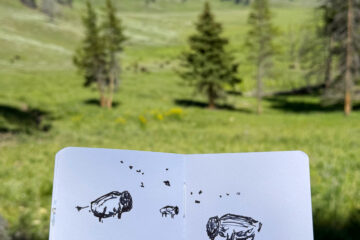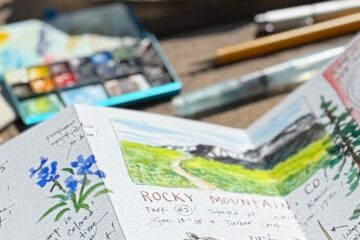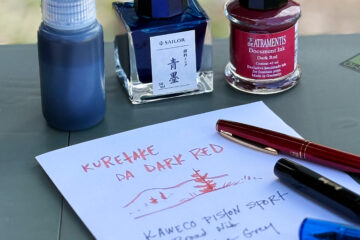I just finished up my Laws Sketchbook for Nature Journaling and thought I’d post a review. (Find it HERE in Jack’s shop.)
For those who haven’t heard of him, John Muir “Jack” Laws is one of my heroes — I think of him as the father of the nature journaling movement and he’s an all-around amazing human. He has many excellent tutorials on his site and the nature journaling community is an inspiring group.

I used his sketchbook to take notes and do sketches during the 2021 and 2022 Wild Wonder Nature Journaling Conferences — it just seemed appropriate! This year’s conference wrapped up on September 18th, but video access of the recordings will be available for purchase around October 1. I can’t recommend these conferences enough — I’ve learned so much, and it’s a great way to hang out with fellow nature journalers!
About the Sketchbook
From the shop description:
- 64 pages of 148g white paper, 16 pages of 200g light brown toned paper–excellent for sketching in pen, pencil, and light watercolor washes. This paper is Acid-free.
- 16 pages of reference material on journaling, observation, and sketching including scientific measurement and estimation tools, the Beaufort Wind Scale, and table of contents (you fill it in as you go to help you reference your notes).
- convenient 7″ x 9″ size with an elastic band.
Gallery
Here’s a super quick flip-thru of my sketchbook:
And since that goes by so fast, here’s a few of my favorite pages — click on an image to see it larger:









Review
I really put this sketchbook to the test! Here are the results:
- The paper has a pretty smooth surface without much tooth. I really like how it has both tan and white paper. The tan paper is very smooth which surprised me as most toned papers that I’ve used have more texture. I’d describe the texture as being like printer paper.
- The white pages are a little thin so you can see through to the other side but it really didn’t bother me.
- This makes it great for pen and ink — I love how a pen just glides over the surface.
- It handles gouache fabulously — see the woodpecker sketches above.
- It can handle very light watercolor washes without too much warping as in the Ruby Crowned Kinglet sketch. Tip: use a waterbrush so that you don’t get too carried away with water.
- Watercolor and colored pencils also work great!
- I took the sketchbook on a few adventures and it’s a nice size to hold while sketching standing up and wasn’t too heavy to haul around in my pack.
- There are several pages of reference materials in the back that are chock-full of good info!
Bottom line: This was a really fun sketchbook to use! However, I don’t think I’ll be buying another as I like to use heavier washes of watercolor. It was great for taking notes during the conference!
Hope that helps someone out there and let me know if you have any questions!



7 Comments
Mary F Hazlett · September 19, 2022 at 4:57 pm
Thanks, Lisa. I bought the sketchbook a couple of years ago, but haven’t used it. Good idea to use it as a “note”book/pencil sketchbook. I’m wondering if another option would be watercolor pencils.
Lisa Spangler · September 19, 2022 at 6:36 pm
Hi Mary! Yes, it works great for watercolor pencils with a waterbrush.
Mary F Hazlett · September 19, 2022 at 6:48 pm
😀
Bob Cochran · September 19, 2022 at 7:04 pm
Hi Lisa! Do watercolor pencils used with waterbrushes have a more difficult learning curve to achieve “just the right effect” than doing the same with one or more classic brushes? Using watercolor pencils requires a different skills in applying the paint and waterbrush, right?
Bob Cochran · September 19, 2022 at 5:23 pm
Hi Lisa! I’m happy that you posted today. I was thinking of you while I was on a walk and I was wondering when you would post again. I’m so pleased that you did. I wonder what is toned paper useful for? What does it offer to an artist? Does toned paper perform differently in the field, versus an indoor setting? I recently went to a Plaza Art store and noticed toned watercolor papers on the shelves. I am hoping to resume my quest to learn watercolor painting and drawing. I’ve signed up for a beginner watercolor class, but I’m on a waiting list and don’t expect to make the class till 2023 sometime. Your drawing and painting skills are superb. I think if someone showed me an unsigned work by you, and challenged me to identify the artist, I’d be able to. Oh, one last question unrelated to wartcolor art or drawing: how can a person protect owls and encourage them to brood?
Lisa Spangler · September 19, 2022 at 6:42 pm
Hi Bob! You just made my day! I’m smiling from ear to ear — thank you!
I didn’t try this particular toned paper in the field, although I have tried other brands and they work as you’d expect based on humidity. Toned paper is great for using with white gouache or other pastel tones — it really makes the whites pop that way! This one has a bit of a coating on it and is super smooth for pens.
Good luck getting into the class. Personally, I found that doing a quick watercolor sketch a day really made a difference. It will come, just enjoy the process.
As far as owls go, I’m no expert on that one. We put up an owl nesting box in our backyard and the only residents we had were wasps! Doh!
Bob Cochran · September 19, 2022 at 7:55 pm
I studied your post with more care and I also looked at the Wild Wonder Nature Journaling Conference links provided. Particularly the class schedule. How very interesting! For example I see that last Saturday, there was a class with the title “From Caterpillar to Butterfly”. I know of a local couple close to my home. They have been providing a group of 3 parsley caterpillars with all the parsley they could want in hopes that they will develop into black swallowtail butterflies. I don’t know what Kristin Meuser taught exactly, of course, but the title is certainly interesting. Maybe my friends would be interested in journaling their efforts to assist the caterpillars and butterflies.
I learn from each of your posts, Lisa. Thank you from a grateful beginning artist.